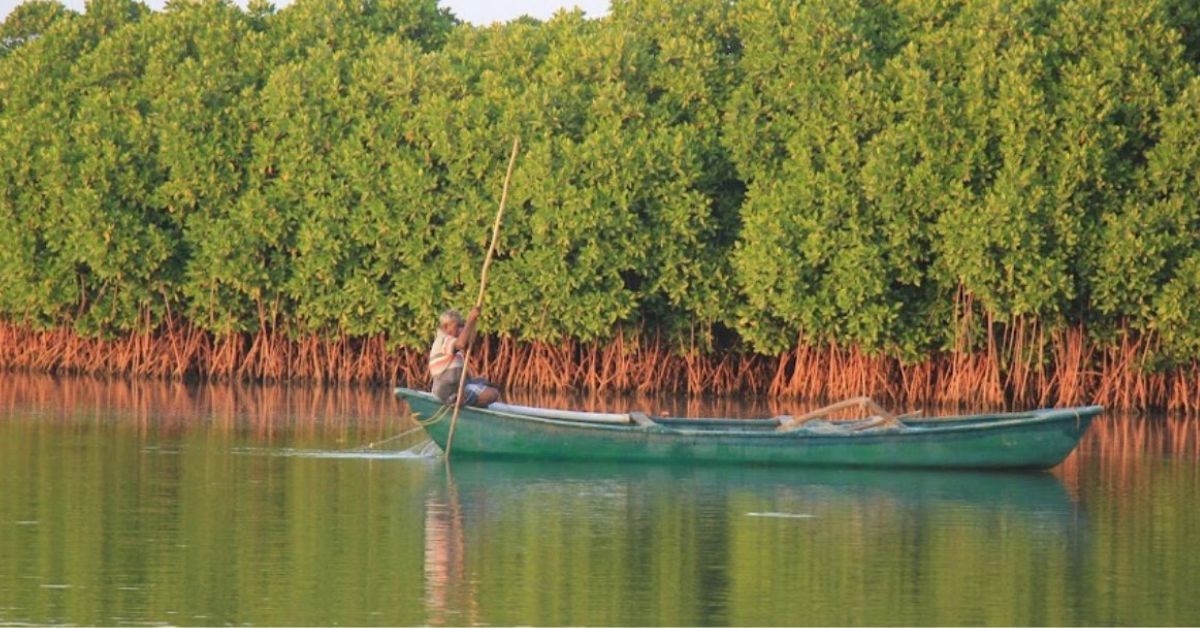How Science, Tradition, & 10000 Villagers Revived Tamil Nadu’s Largest Mangrove Forest
1. Why Muthupet matters: A vital wetland under threat
Nestled at the confluence of the Koraiyar and Pamaniyar rivers and opening into the Palk Strait, the Muthupet wetland complex in Tamil Nadu spans 120 sq. km and is the largest mangrove forest in the state. As part of the Point Calimere Ramsar site, it plays a vital role in:
- Supporting biodiversity, including over 100 species of migratory waterbirds like Spot-Billed Pelicans and Lesser Flamingos.
- Protecting coastal villages from cyclonic storm surges, erosion, and sea-level rise.
- Acting as a carbon sink and fish nursery for surrounding fishing communities.
However, over the years, silt accumulation, blocked tidal inflows, and canopy loss led to large-scale degradation. Once-thriving forest patches turned into barren mudflats, threatening biodiversity and jeopardising the livelihoods of thousands of fisherfolk who depended on the wetland ecosystem.
2. A joint mission: Government and communities unite
The restoration of Muthupet’s mangroves was launched under the Green Tamil Nadu Mission between 2022 and 2025, led by:
- Tiruvarur Forest Division, under District Forest Officer (DFO) LCS Srikanth
- State-wide oversight by Supriya Sahu, Additional Chief Secretary, Environment, Forests and Climate Change Department
What made this mission unique was the integration of scientific planning with grassroots participation. Officials mobilised over 10,000 residents from 16 fishing villages, including Veerankoil and Thondiyakadu, through the formation of Village Mangrove Councils (VMCs). These councils became local governance units, combining traditional knowledge with structured ecological intervention.
Community members contributed to everything from planting and guarding saplings to repairing canals and ensuring regular tidal flow. This sense of shared ownership was central to the project’s long-term viability.
3. How they did it: Scientific design meets traditional knowledge
A. Canal network design: Enabling natural tidal flushing
One of the key challenges was restoring natural tidal flow to waterlogged or dry zones. This was addressed through two engineering models:
- Fishbone Design: Mimicking the structure of a fish skeleton, this model creates a central canal with smaller lateral canals extending outward. It allows tidal waters to flow deep into mangrove areas, enabling proper flushing, salinity balance, and seed dispersal.
- Box Design: A rectangular network of interlinked canals, suitable for flat terrain with stagnant water. This ensures uniform water circulation, reducing the chance of stagnation or salinity imbalance.
Using these models, over 380 km of canals were desilted or newly excavated, ensuring tidal connectivity to all restoration zones. These canals allowed mangrove propagules—buoyant seed pods—to disperse naturally and take root in nutrient-rich sediment.
B. Planting strategy: Species selection and spacing
The project focused on restoring native species that were historically dominant in the region:
- Avicennia marina (grey/white mangrove): Constitutes 95% of Tamil Nadu’s mangrove cover due to its high salinity tolerance and rapid growth.
- Rhizophora mucronata (red mangrove): Introduced to improve soil stabilisation and biodiversity.
- Aegiceras corniculatum (black mangrove): Adds to species diversity and ecological resilience.
 Muthupet is largest mangroves in the state. Pic credits @TNGeography/X
Muthupet is largest mangroves in the state. Pic credits @TNGeography/X
Over 12 lakh mangrove propagules were carefully planted at optimal intervals, taking tidal height, soil type, and seasonal rainfall into account. These efforts were complemented by manual sapling transplants in areas unsuitable for natural seed dispersal.
4. The numbers behind the revival: Area, jobs & biodiversity
The restoration effort covered a total of 2,057 hectares:
- 1,350 hectares of new plantations (with direct planting)
- 707 hectares restored by canal desilting and hydrological repair
By location:
- 1,482 hectares in Thanjavur district
- 575 hectares in Tiruvarur district
Beyond the ecological benefits, the project became a major source of rural employment:
- In 2022–23, over 31,000 person-days of paid work were created.
- In 2023–24, another 32,397 person-days were recorded.
- Cumulatively, more than 86,000 workdays were generated across planting, canal work, monitoring, and maintenance.
This enabled direct income generation for women’s self-help groups, landless labourers, and traditional fishers, further enhancing local support for the project.
5. Signs of life: Ecological and social impact
The revitalised ecosystem has begun to show tangible signs of recovery:
- Bird migration has resumed in restored zones, with sightings of flamingos, pelicans, herons, and waders increasing each year.
- Fish nursery density has improved, as fingerlings now find shelter among mangrove roots, benefiting the local fishing economy.
- Soil quality and coastal sediment retention have shown marked improvements, reducing erosion risk.
Importantly, the success of Muthupet’s restoration has rekindled ecological stewardship among locals. Children are taken to see saplings they helped plant. Community members now report mangrove encroachment or damage to forest officials, indicating a shift from passive dependence to active guardianship.
Looking ahead, the Tamil Nadu government has identified an additional 700 hectares for plantation and 800 hectares for restoration, ensuring that Muthupet’s momentum continues.
A model for wetland restoration in India
The revival of Muthupet’s mangroves is more than an environmental success—it is a model of collaborative governance, ecological engineering, and community engagement. It demonstrates that when scientific planning meets traditional wisdom, and when government aligns with grassroots leadership, even the most degraded ecosystems can be brought back to life.
This project doesn’t just restore trees — it rebuilds resilience, livelihoods, and trust in the power of collective action. As coastal ecosystems face mounting pressure from climate change, Muthupet offers a replicable blueprint for other vulnerable regions across India.
News